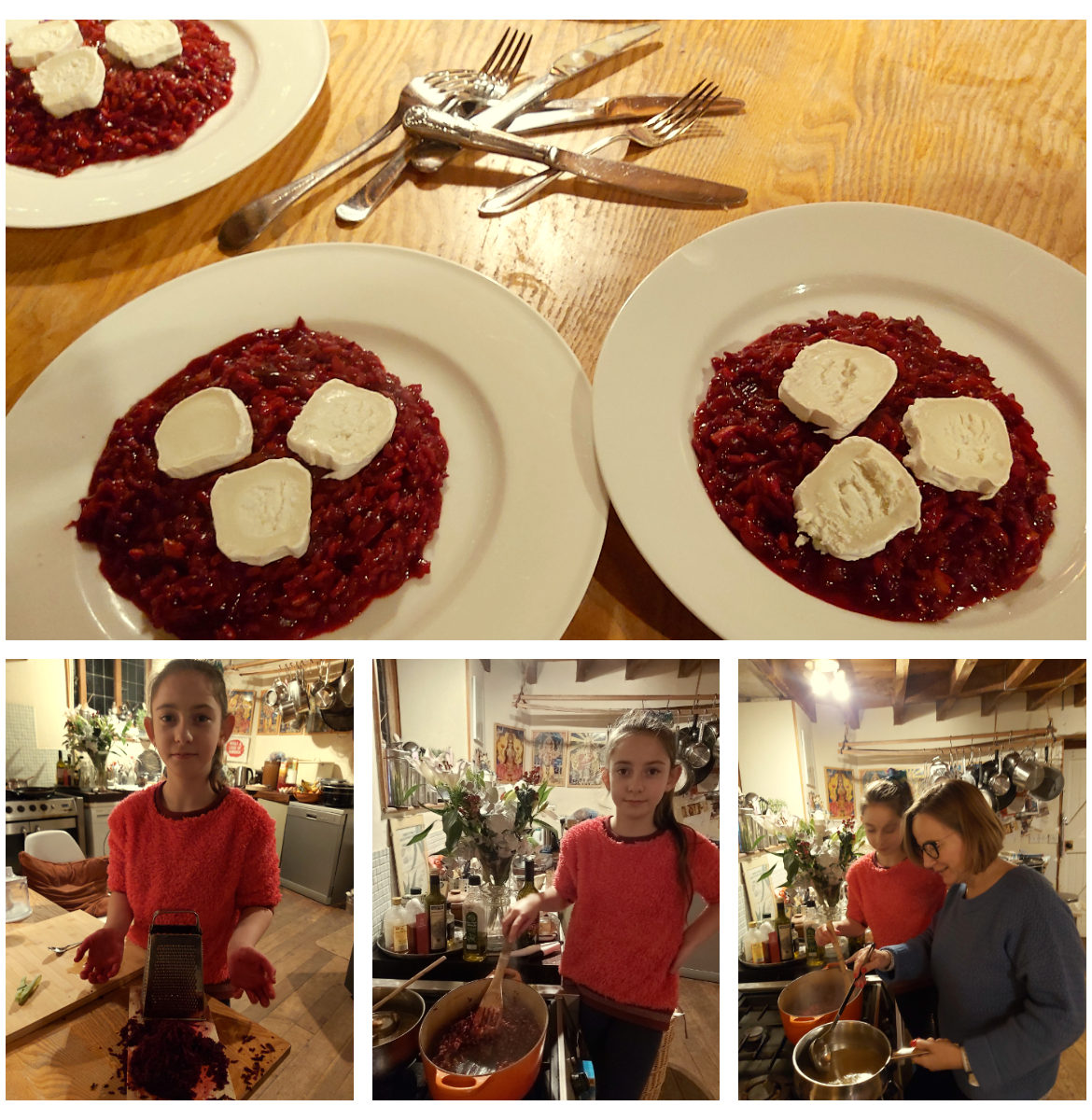
A simple but stunning “Romanian risotto” bursting with flavor and color. I have to credit my Mum for this ingenious recipe and helping me perfect it. Beetroot, local goat’s cheese, thyme and lovage are the key flavors here with the sweetness of the beetroot and lovage contrasting with the goat’s cheese. Making risotto is oddly hypnotic – stirring in circles, sipping a glass of wine and watching something slowly change form in front of you. Slow slow food indeed that is just so right on a chilly evening, glass in hand.
Use the best quality saucepan you have with a wide base unless you are the proud owner of a risotto pan. You want slow well conducted heat and a large surface area. I always used to cook risotto in a le Creuset casserole dish until it got lost in another move, the thick iron base of such pans is ideal. A wooden spatula with a straight edge (important). Other than these two basic but important items no special equipment is required.
Here I cook with my trusty sous chef
Ingredients for Four People
30g butter
2 tbsp olive oil
- 400g fresh beetroot
- 1 onion finely chopped
- 2 garlic cloves, finely chopped
- leaves from 2 sprigs thyme
- 900ml – 1 liter chicken or vegetable stock if serving for vegetarians
- 250g risotto rice like Carnaroli or Arborio, although faced with unavailability in Bucharest I have successfully made with normal short grain sticky rice
- 125ml dry vermouth /white wine and I think I have made it with red wine as well
- 110g parmesan or pecorino, finely grated
- One log of goats cheese with rind cut into slices – 2 or 3 slices per person. Or a good crumbly goats cheese/feta that you crumble over the final risotto. I have also made it with blue cheese sprinkled on top but kind of like the goat’s cheese version.
- Chopped lovage (“leustean”) – optional
How To:
Grate the beetroot as you would grate carrots. Choose smaller beetroot to guarantee flavour, deep color and concentration of vitamins. Chop the onion and garlic very finely. Grate the parmesan and chop the lovage. Check your wine and vermouth.
Place the stock (I use chicken stock) to boil so the stock is the same temperature as the risotto. If you don’t have good quality vegetarian stock then a clever tip is to use the liquid left over from soaking wild mushrooms. This heavenly liquor not only contains much goodness but creates depth of flavor to your risotto. So next time you soak the porcini – bag and freeze that precious liquid!
Measure the rice, grab a block of butter and you are ready to cook!
Put your chosen pan on a low heat. Saute the onions, garlic and beetroot in the butter and olive oil until the onions are transparent and cooked. The beetroot will still be crunchy – this is fine.
Add the rice and the vermouth and start stirring. Risotto requires constant stirring and as you near the end you must test the grains. It is done when the rice is cooked but not too mushy and there is a pleasant creamy texture that is created from the rice starch.
As soon as the liquid is absorbed but keeping the mixture creamy and not over dry add a ladleful of hot stock. Stir gently until this is absorbed. Keep repeating the process, adding ladle-fulls of stock one at a time until your rice is cooked. The bottom of the pan must always be clear when you run the spatula over it during the entire process and the rice must never stick. By this time the risotto will be a vibrant “hot pink” color. Near the end add the fresh thyme and salt and pepper to taste. Thyme really is a key flavor here – try not to skip it.
When the rice is cooked, take the pan off the heat and let the risotto relax for a couple of minutes. Add the parmesan and stir through gently and, if you feel like it, add a knob of butter as well.
Serve in soup bowls or on plates. Arrange the goat’s cheese slices or crumble it ( depending on your goat’s cheese) on top and garnish with the chopped lovage. Enjoy!


